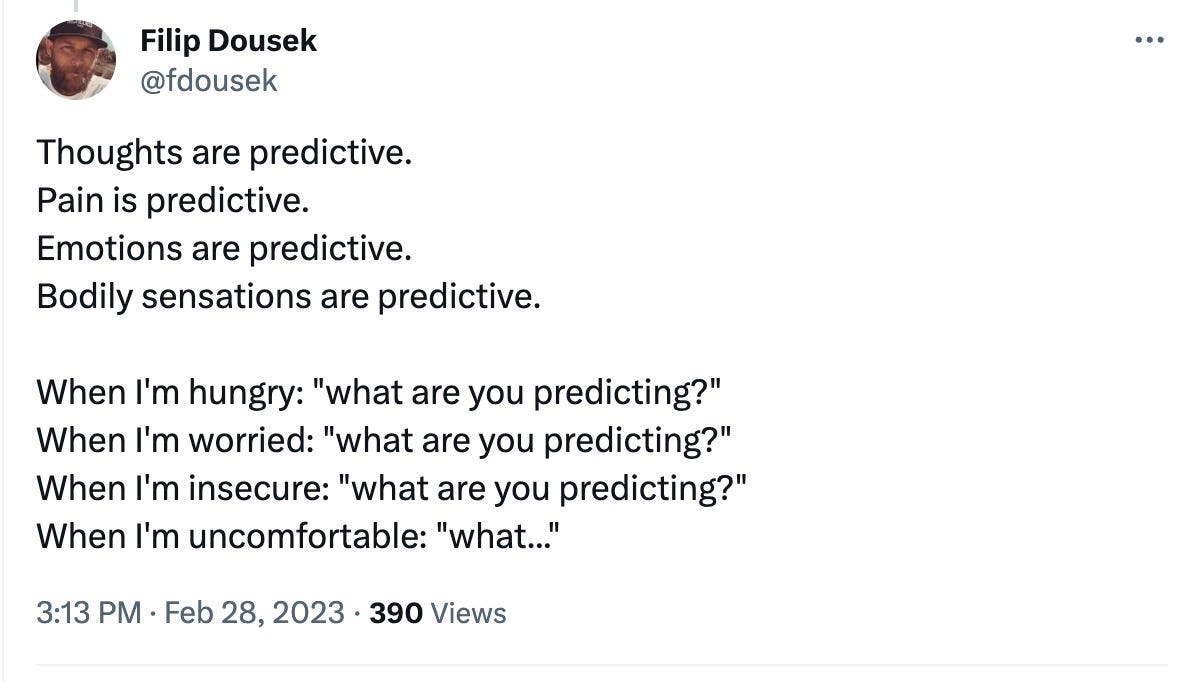Predictive Paradigm: Shadows Cast by Tomorrow (pt. I)
On the Underlying Principle of the Human Experience
So this is what I think is going on in humans.
Life, as we experience it, is a rich tapestry of pleasure, pain, potential, and paradoxes. Yet beneath this chaotic surface, there are guiding principles, almost like physics for the soul. Among these forces, one emerges as a guiding star — elusive, yet omnipresent as life itself. In this three-part essay, I'll dissect how this principle shapes the human experience, hoping to offer practical tools and games for the keen mind.
I could aim for a sprawling book, with each concept expanded into its own chapter. But I’ve done that with an idea once and it took me 12 years to emerge on the other side. So consider this a 'bonsai' version – a compact map of a rugged territory.
But enough with the caveats, here’s what I think is going on in humans. (As of early 2024).
The Body as an Alien Lifeform
When we're born, it's like waking up inside an alien vessel – the human body. It’s familiar because it’s ours, but let's face it, it’s also bizarrely complex. We take it for granted, yet it’s a universe waiting to be explored, weirder than the North Pole, more mysterious than Mars.
But the million-lifetimes question is: How does it work? How do we use it?
In the quest to decode human experience, smart minds have served up some major theories. Nietzsche gave us the 'will to power' – an intrinsic driving force. Darwin explored natural selection, an external sculptor of every living creature. Freud took us on a tour of the unconscious, revealing the hidden drivers of our psyche. René Girard argued that our tendency to imitate is a cornerstone of culture and conflict. Aldous Huxley’s Perennial Philosophy goes on a quest for a universal spiritual truth. Then there are those who place consciousness highest, widening our lens. Different angles, but they all circle around one linchpin idea: prediction.
Prediction is the silent orchestrator of human life. Every joy, every pain, our entire memory tapestry, our beliefs and stories, they’re all prediction plays. Pain is a warning from our future self; haunting memories are echoes of expectations gone awry; beliefs are our brain's bets on what's next. Truth is a probabilistic model. And stories? They are canned probabilities, containers of what-ifs. Whenever the body or life feels alien, difficult, or hostile, I will bet that it has to do with prediction.
This insight into prediction isn't just academic; it's transformative. It offers a kind of freedom – a way to rewire how we interact with life. Consider this:
If you could choose any feeling at will, what would it be? And what's holding you back from feeling it now?
The following text is a toolkit to dismantle those barriers.
The Shapes of Tension
For as long as I remember, I’ve had what I would call too much tension. This has been a persistent challenge for me for at least the past 15 years, during which I've approached it from the body, the soul, the calm, and the goddamn rage.
I often think of amateur climbers who cling to the wall with far more power than necessary. Mastery lies in applying the least force possible, a skill that eluded me for years. However, tension has been more than just a nuisance.
I've learned that among the many entry points into the human experience, tension is a secret passage. It's easy to view tension as an unwanted guest, something to be eliminated in order to feel. Yet, it's not merely a byproduct of life; I eventually realized that it is an integral part of our predictive machinery.
Consider tension and pain as cryptic messages from the body's own forecasting system. What are they signaling? Trauma, fear, lessons to be learned? Yes, but there's more. These sensations are part of the body's way of predicting and responding to its environment. To really tune into this predictive dialogue, we need to observe the shape of our tension.
This 'shape' is as unique as a fingerprint. One person's relaxation in a sauna might be another's discomfort. Fatigue might be omnipresent or suddenly weigh on the legs. And these individual patterns trace the contours of our personal predictive maps.
Are they difficult to read?
Try and observe the shape of your tension and pain for a few weeks, until it becomes quite clear. Step back and see how that shape molds the narrative of your life.
You may find that tension and pain define life like an outer ring. They outline the limits you instinctively avoid crossing. They form the edges of your comfort zone, hinting at what your body and mind anticipate as stressors or threats.
Do you feel rigid in chats with the rich and the beautiful? Does a conversation with your boss feel like a shot of stresspresso? Do you have recurrent nightmares of school exams? What’s more tiring — a 10-hour flight or a 10-mile run? What do you shy away from? There you have it — the shape of your tensions becomes the shape of your life.
In this light, tension becomes a crucial clue, a way to understand not just our reactions to the present, but our anticipations of the future. It's a window into how our nervous system encodes the complexities of our existence. It’s like a translation app. It’s input is life’s complexities and it’s output is a shape of risk, made of a trivially simple substance — tension. Or, in other terms:
The tension system predicts future risks in the form of a vibrating shape of unpleasant frequencies.
When we start speaking of vibrations, there's a risk that the conversation may go sideways quickly. So in the next section, we'll talk more about the physical components of this system: smooth muscle, vasoconstriction, and their neural correlates.
The Psycho-Physical Bridge
You're emerging from a sauna, steam still clinging to your skin, making your way toward the icy plunge of an ice bath. Before your toe even brushes the water, your heartbeat goes up and your inner space shrinks in anticipation of the piercing cold. Then, when you take the first step into the freezing water, the whole process accelerates to an almost overwhelming cocktail of sensations. Your vessels constrict in anticipation of prolonged danger and pain curls up your feet to protect you. Your prediction systems run in overdrive, conjuring up a shape of danger.
And there’s basically one advice: Chill out. Literally and figuratively. Breathe. Slowly.
Why? Because that way, you are bringing your layers of predictive systems into alignment (via a process of neural annealing (short, long version)). You are forcing them to communicate their dissonance and, if your conscious willpower is strong enough, you are redrawing the predictive maps of your lower systems with a command of safety on the conscious level. You are upgrading your deep prediction models to feel safer than they currently do.
This principle can be applied to exercise, meditation, stress, and other liminal states. It can raise empathy in arguments just as resilience at work. The principle that helps us grow is indeed universal:
When tension grabs you, notice it and consciously help your lower systems relax.
This would almost sound trivial if a) it wasn’t so bloody difficult to do b) we wouldn’t take it as a springboard to explore the fine tapestry of the predictive machinery. Both of these caveats provide for depth of exploration.
Michael Edward Johnson sheds light onto the underlying principles of this bodily process, which he calls vasocomputation. (I wholly recommend reading the whole text, and in particular the sections explaining compression pressure and metabolizing uncertainty, both of which offer deep insights into the physics of prediction.) Johnson proposes that the vascular system does not merely provide blood to the brain (and the rest of the body). As it evolved before the neural system (with which it is intricately connected), it was likely a more primitive system with the same role — prediction.
So the predictive capability in humans may have evolved as follows:
vascular system → neural system → consciousness → language
As systems sharing the same crucial function, these layers collaborate in an orchestrated manner, creating the psychosomatic bridge. And to reiterate the main point: this psychosomatic bridge’s key function is prediction. This is its primary optimization. This leads to my suggestion that we interpret all our emotional states as predictive in nature, rather than reactive.
But what role does tension serve in prediction? Why do we go through life with so much clenching?
(More on vasocomputation here and here).
To paraphrase, tension appears to be a restriction of the possible states, (movement, action, feelings, thoughts, qualia), in a certain area. It works as a precision radio jammer, which uses an interfering frequency to prevent the transmission of other signals. Quite fascinatingly it’s a single, simple mechanism that works as a universal restrictor, like a bouncer at the door of your life. This mechanism is essential to regulate the amount of energy we process, based on how much we can handle.
But said more precisely:
Tension regulates the amount of future energy we expect to process, based on how much we expect we will handle.
Understood this way, tension is our steering mechanism in the face of the unknown. It’s a projection of our expectations onto our body, making these expectations visible and actionable. Tension is a shadow — a shadow cast by tomorrow.
In the next part, we will explore the very fabric of tomorrow, i.e. the physics of beliefs.








